Analyzing CEO Leadership and Organizational Strategies at ASOS Plc
VerifiedAdded on 2022/11/25
|13
|4007
|149
Report
AI Summary
This report provides a comprehensive analysis of ASOS Plc, examining the managerial styles of its CEO through the lens of Henry Mintzberg's managerial roles, including figurehead, leader, and negotiator. It explores the steps necessary for the CEO to implement organizational changes to enhance performance, focusing on preparing for and explaining these changes, acknowledging potential losses, and creating a positive climate. The report also delves into various leadership styles, such as authoritarian, participative, and transformational leadership, and their impact on organizational effectiveness. Furthermore, it investigates the effects of power, influence, and conflict on employees, including their impact on morale, productivity, and turnover. Finally, it outlines different motivation strategies that ASOS Plc can employ to enhance employee engagement and drive organizational success. The report uses relevant examples and literature to support its findings and concludes with strategic recommendations.
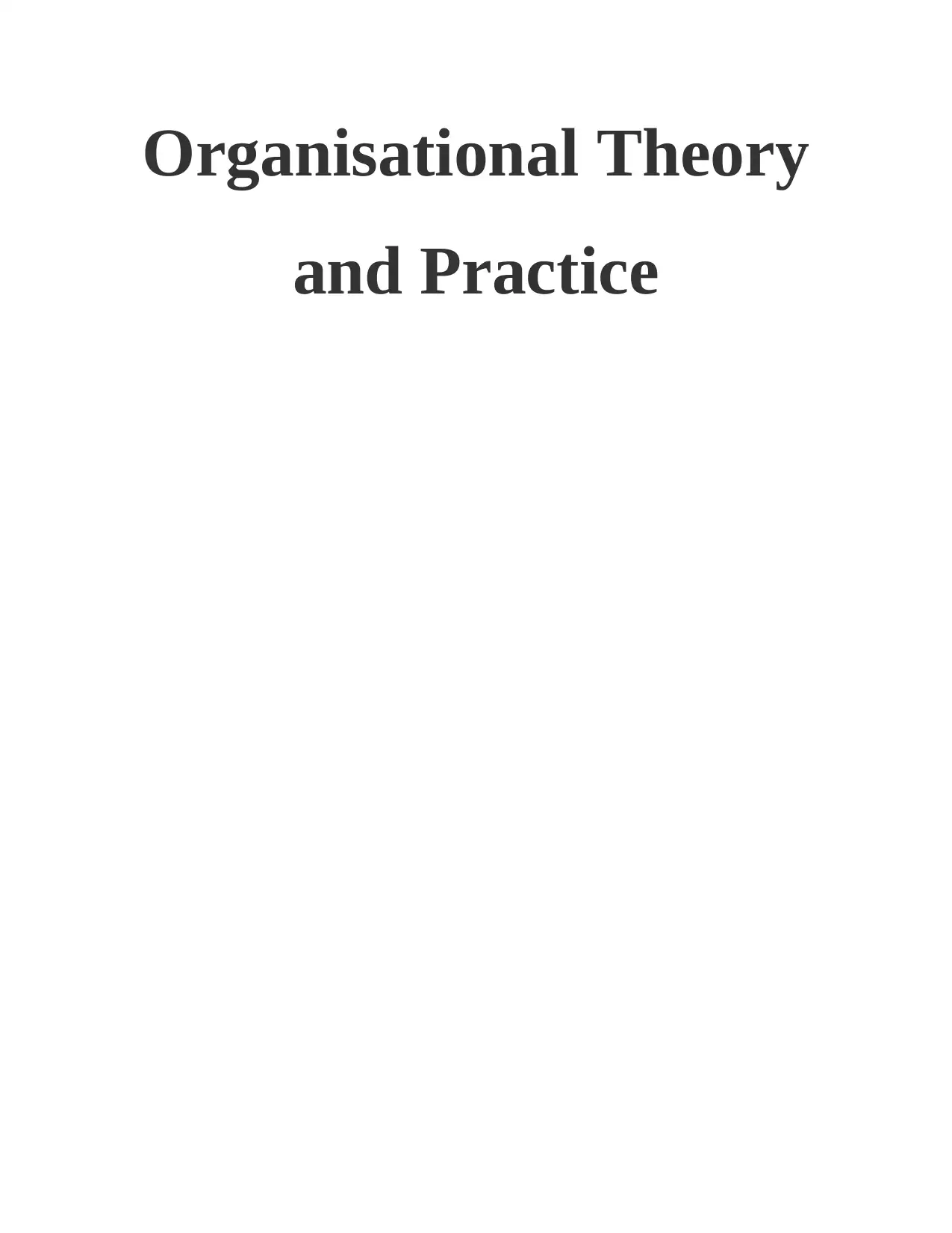
Organisational Theory
and Practice
and Practice
Paraphrase This Document
Need a fresh take? Get an instant paraphrase of this document with our AI Paraphraser
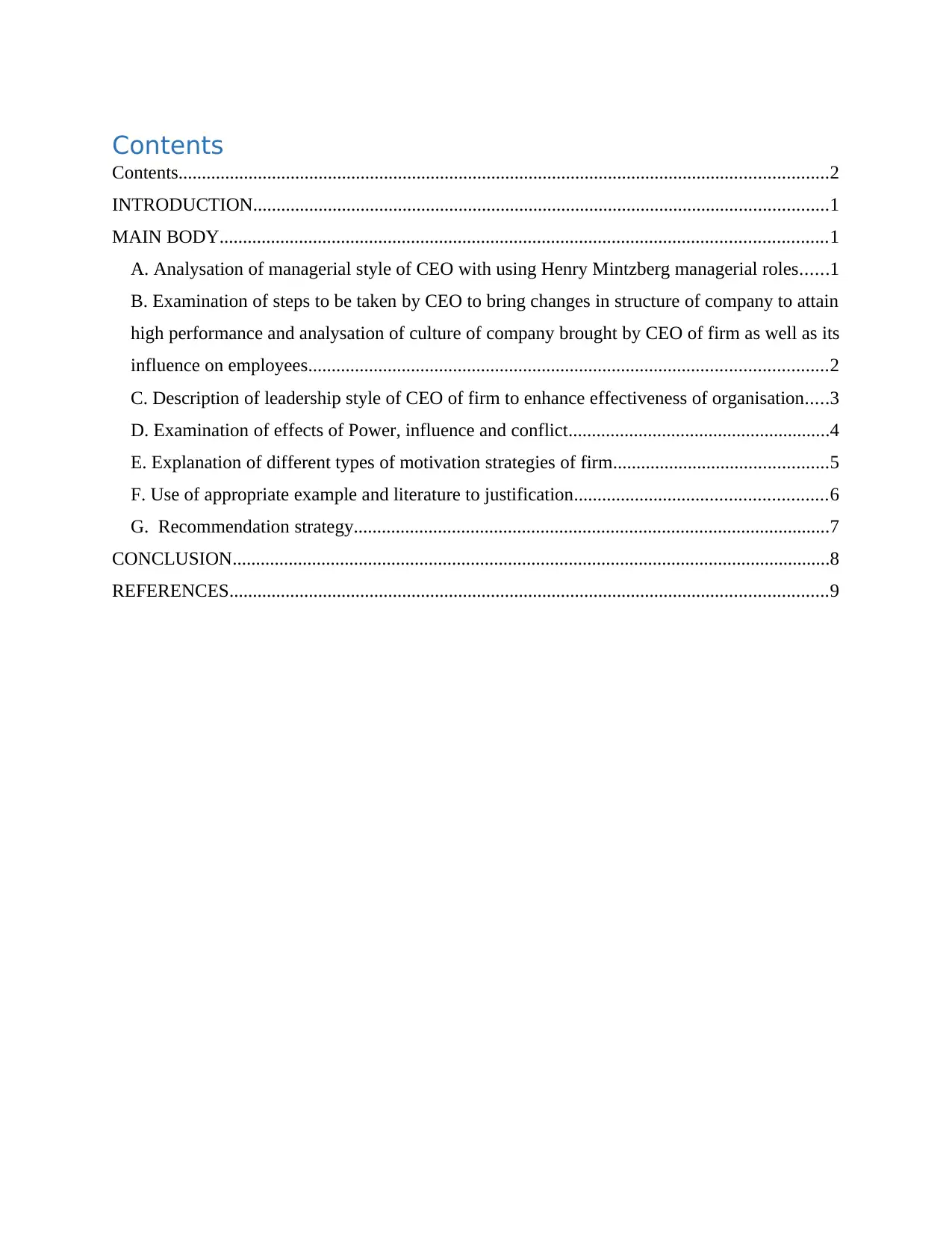
Contents
Contents...........................................................................................................................................2
INTRODUCTION...........................................................................................................................1
MAIN BODY..................................................................................................................................1
A. Analysation of managerial style of CEO with using Henry Mintzberg managerial roles......1
B. Examination of steps to be taken by CEO to bring changes in structure of company to attain
high performance and analysation of culture of company brought by CEO of firm as well as its
influence on employees...............................................................................................................2
C. Description of leadership style of CEO of firm to enhance effectiveness of organisation.....3
D. Examination of effects of Power, influence and conflict........................................................4
E. Explanation of different types of motivation strategies of firm..............................................5
F. Use of appropriate example and literature to justification......................................................6
G. Recommendation strategy......................................................................................................7
CONCLUSION................................................................................................................................8
REFERENCES................................................................................................................................9
Contents...........................................................................................................................................2
INTRODUCTION...........................................................................................................................1
MAIN BODY..................................................................................................................................1
A. Analysation of managerial style of CEO with using Henry Mintzberg managerial roles......1
B. Examination of steps to be taken by CEO to bring changes in structure of company to attain
high performance and analysation of culture of company brought by CEO of firm as well as its
influence on employees...............................................................................................................2
C. Description of leadership style of CEO of firm to enhance effectiveness of organisation.....3
D. Examination of effects of Power, influence and conflict........................................................4
E. Explanation of different types of motivation strategies of firm..............................................5
F. Use of appropriate example and literature to justification......................................................6
G. Recommendation strategy......................................................................................................7
CONCLUSION................................................................................................................................8
REFERENCES................................................................................................................................9

⊘ This is a preview!⊘
Do you want full access?
Subscribe today to unlock all pages.

Trusted by 1+ million students worldwide
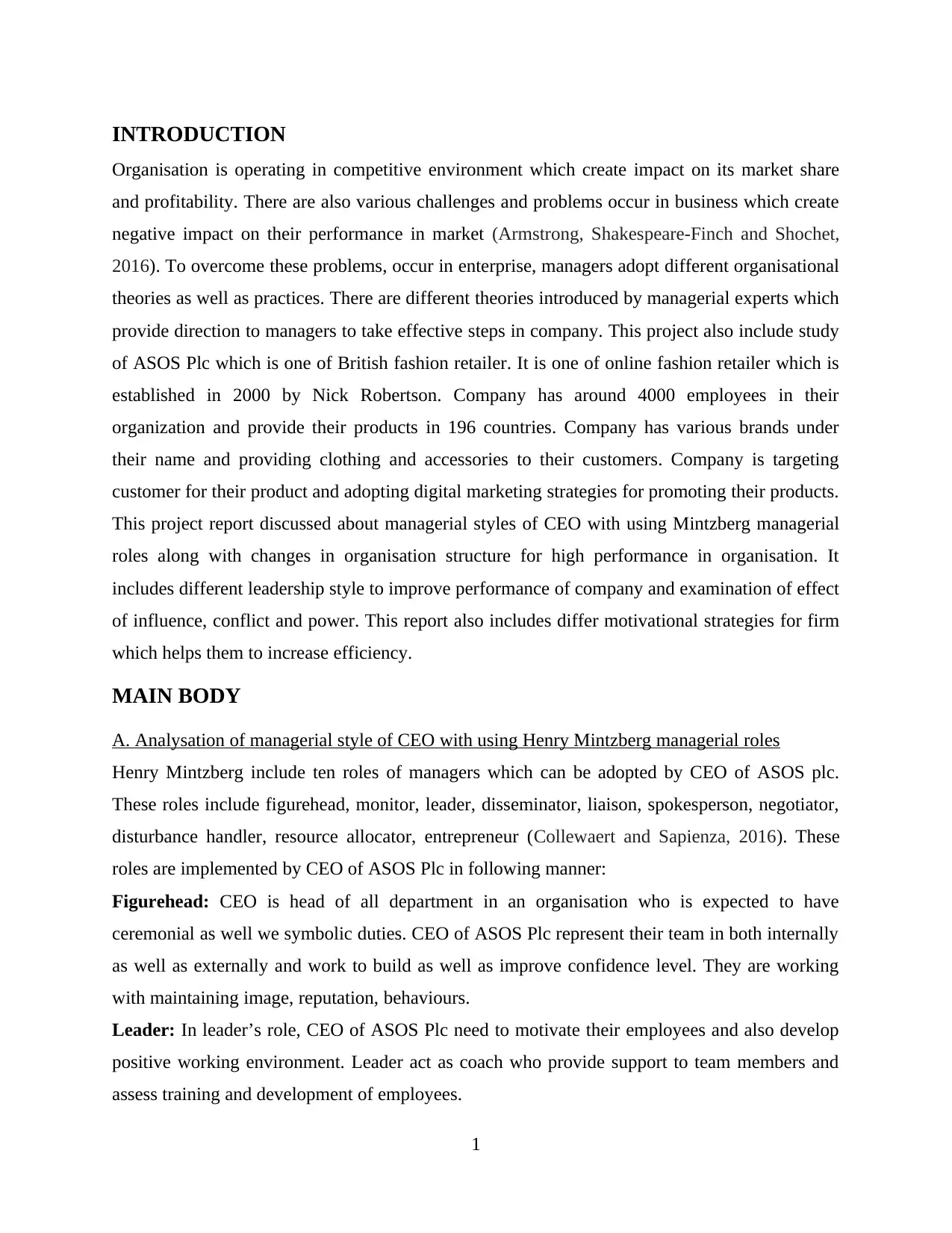
INTRODUCTION
Organisation is operating in competitive environment which create impact on its market share
and profitability. There are also various challenges and problems occur in business which create
negative impact on their performance in market (Armstrong, Shakespeare-Finch and Shochet,
2016). To overcome these problems, occur in enterprise, managers adopt different organisational
theories as well as practices. There are different theories introduced by managerial experts which
provide direction to managers to take effective steps in company. This project also include study
of ASOS Plc which is one of British fashion retailer. It is one of online fashion retailer which is
established in 2000 by Nick Robertson. Company has around 4000 employees in their
organization and provide their products in 196 countries. Company has various brands under
their name and providing clothing and accessories to their customers. Company is targeting
customer for their product and adopting digital marketing strategies for promoting their products.
This project report discussed about managerial styles of CEO with using Mintzberg managerial
roles along with changes in organisation structure for high performance in organisation. It
includes different leadership style to improve performance of company and examination of effect
of influence, conflict and power. This report also includes differ motivational strategies for firm
which helps them to increase efficiency.
MAIN BODY
A. Analysation of managerial style of CEO with using Henry Mintzberg managerial roles
Henry Mintzberg include ten roles of managers which can be adopted by CEO of ASOS plc.
These roles include figurehead, monitor, leader, disseminator, liaison, spokesperson, negotiator,
disturbance handler, resource allocator, entrepreneur (Collewaert and Sapienza, 2016). These
roles are implemented by CEO of ASOS Plc in following manner:
Figurehead: CEO is head of all department in an organisation who is expected to have
ceremonial as well we symbolic duties. CEO of ASOS Plc represent their team in both internally
as well as externally and work to build as well as improve confidence level. They are working
with maintaining image, reputation, behaviours.
Leader: In leader’s role, CEO of ASOS Plc need to motivate their employees and also develop
positive working environment. Leader act as coach who provide support to team members and
assess training and development of employees.
1
Organisation is operating in competitive environment which create impact on its market share
and profitability. There are also various challenges and problems occur in business which create
negative impact on their performance in market (Armstrong, Shakespeare-Finch and Shochet,
2016). To overcome these problems, occur in enterprise, managers adopt different organisational
theories as well as practices. There are different theories introduced by managerial experts which
provide direction to managers to take effective steps in company. This project also include study
of ASOS Plc which is one of British fashion retailer. It is one of online fashion retailer which is
established in 2000 by Nick Robertson. Company has around 4000 employees in their
organization and provide their products in 196 countries. Company has various brands under
their name and providing clothing and accessories to their customers. Company is targeting
customer for their product and adopting digital marketing strategies for promoting their products.
This project report discussed about managerial styles of CEO with using Mintzberg managerial
roles along with changes in organisation structure for high performance in organisation. It
includes different leadership style to improve performance of company and examination of effect
of influence, conflict and power. This report also includes differ motivational strategies for firm
which helps them to increase efficiency.
MAIN BODY
A. Analysation of managerial style of CEO with using Henry Mintzberg managerial roles
Henry Mintzberg include ten roles of managers which can be adopted by CEO of ASOS plc.
These roles include figurehead, monitor, leader, disseminator, liaison, spokesperson, negotiator,
disturbance handler, resource allocator, entrepreneur (Collewaert and Sapienza, 2016). These
roles are implemented by CEO of ASOS Plc in following manner:
Figurehead: CEO is head of all department in an organisation who is expected to have
ceremonial as well we symbolic duties. CEO of ASOS Plc represent their team in both internally
as well as externally and work to build as well as improve confidence level. They are working
with maintaining image, reputation, behaviours.
Leader: In leader’s role, CEO of ASOS Plc need to motivate their employees and also develop
positive working environment. Leader act as coach who provide support to team members and
assess training and development of employees.
1
Paraphrase This Document
Need a fresh take? Get an instant paraphrase of this document with our AI Paraphraser
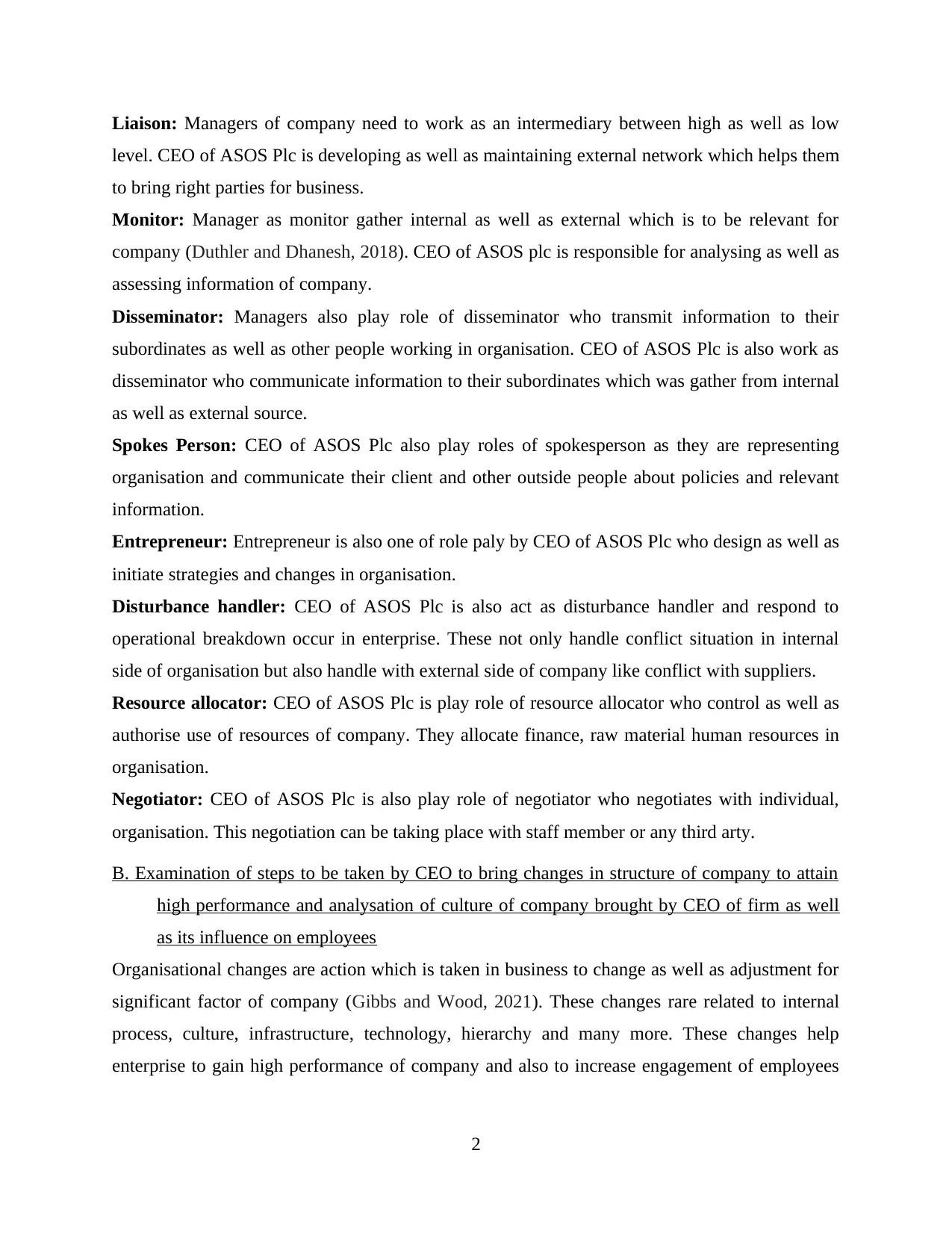
Liaison: Managers of company need to work as an intermediary between high as well as low
level. CEO of ASOS Plc is developing as well as maintaining external network which helps them
to bring right parties for business.
Monitor: Manager as monitor gather internal as well as external which is to be relevant for
company (Duthler and Dhanesh, 2018). CEO of ASOS plc is responsible for analysing as well as
assessing information of company.
Disseminator: Managers also play role of disseminator who transmit information to their
subordinates as well as other people working in organisation. CEO of ASOS Plc is also work as
disseminator who communicate information to their subordinates which was gather from internal
as well as external source.
Spokes Person: CEO of ASOS Plc also play roles of spokesperson as they are representing
organisation and communicate their client and other outside people about policies and relevant
information.
Entrepreneur: Entrepreneur is also one of role paly by CEO of ASOS Plc who design as well as
initiate strategies and changes in organisation.
Disturbance handler: CEO of ASOS Plc is also act as disturbance handler and respond to
operational breakdown occur in enterprise. These not only handle conflict situation in internal
side of organisation but also handle with external side of company like conflict with suppliers.
Resource allocator: CEO of ASOS Plc is play role of resource allocator who control as well as
authorise use of resources of company. They allocate finance, raw material human resources in
organisation.
Negotiator: CEO of ASOS Plc is also play role of negotiator who negotiates with individual,
organisation. This negotiation can be taking place with staff member or any third arty.
B. Examination of steps to be taken by CEO to bring changes in structure of company to attain
high performance and analysation of culture of company brought by CEO of firm as well
as its influence on employees
Organisational changes are action which is taken in business to change as well as adjustment for
significant factor of company (Gibbs and Wood, 2021). These changes rare related to internal
process, culture, infrastructure, technology, hierarchy and many more. These changes help
enterprise to gain high performance of company and also to increase engagement of employees
2
level. CEO of ASOS Plc is developing as well as maintaining external network which helps them
to bring right parties for business.
Monitor: Manager as monitor gather internal as well as external which is to be relevant for
company (Duthler and Dhanesh, 2018). CEO of ASOS plc is responsible for analysing as well as
assessing information of company.
Disseminator: Managers also play role of disseminator who transmit information to their
subordinates as well as other people working in organisation. CEO of ASOS Plc is also work as
disseminator who communicate information to their subordinates which was gather from internal
as well as external source.
Spokes Person: CEO of ASOS Plc also play roles of spokesperson as they are representing
organisation and communicate their client and other outside people about policies and relevant
information.
Entrepreneur: Entrepreneur is also one of role paly by CEO of ASOS Plc who design as well as
initiate strategies and changes in organisation.
Disturbance handler: CEO of ASOS Plc is also act as disturbance handler and respond to
operational breakdown occur in enterprise. These not only handle conflict situation in internal
side of organisation but also handle with external side of company like conflict with suppliers.
Resource allocator: CEO of ASOS Plc is play role of resource allocator who control as well as
authorise use of resources of company. They allocate finance, raw material human resources in
organisation.
Negotiator: CEO of ASOS Plc is also play role of negotiator who negotiates with individual,
organisation. This negotiation can be taking place with staff member or any third arty.
B. Examination of steps to be taken by CEO to bring changes in structure of company to attain
high performance and analysation of culture of company brought by CEO of firm as well
as its influence on employees
Organisational changes are action which is taken in business to change as well as adjustment for
significant factor of company (Gibbs and Wood, 2021). These changes rare related to internal
process, culture, infrastructure, technology, hierarchy and many more. These changes help
enterprise to gain high performance of company and also to increase engagement of employees
2
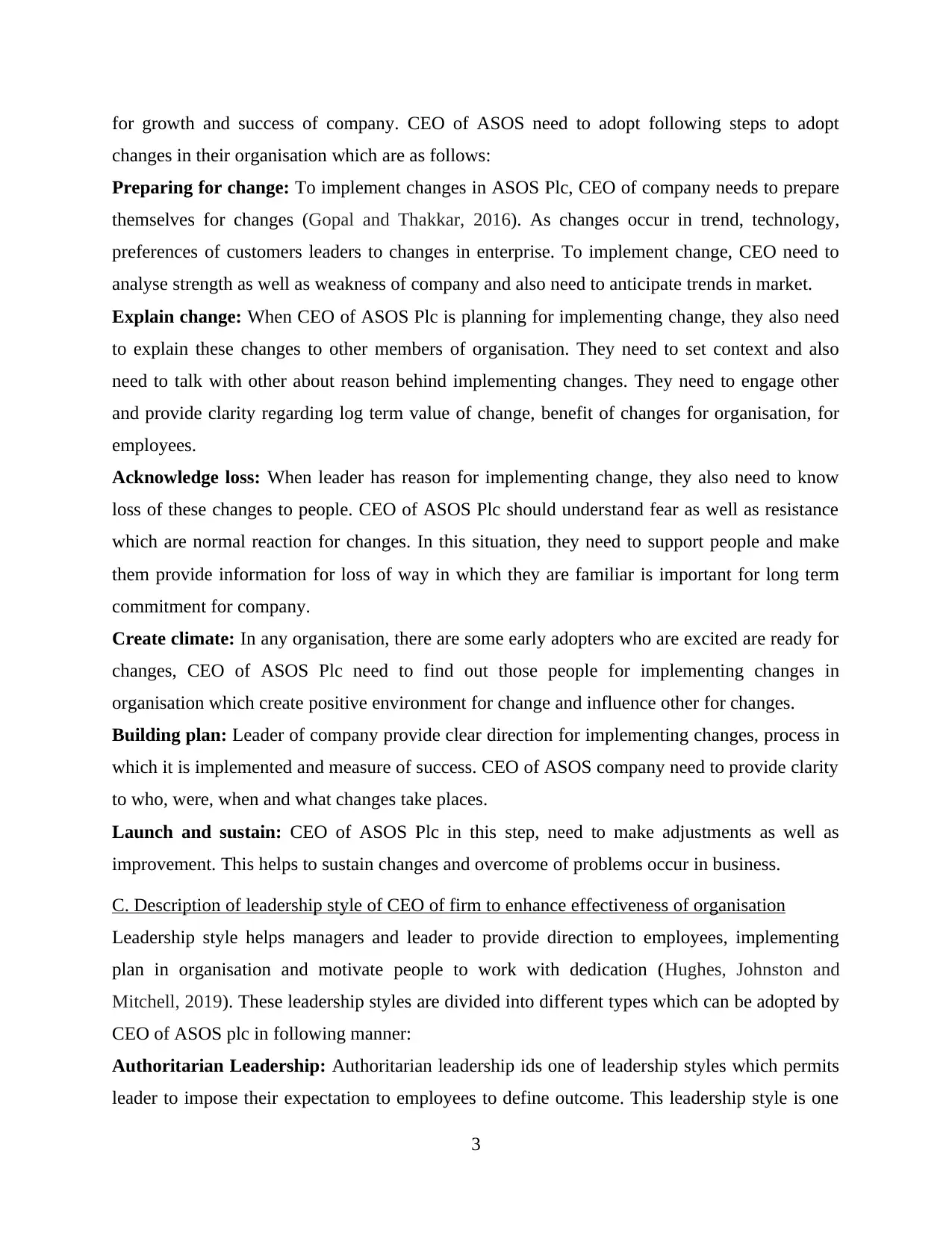
for growth and success of company. CEO of ASOS need to adopt following steps to adopt
changes in their organisation which are as follows:
Preparing for change: To implement changes in ASOS Plc, CEO of company needs to prepare
themselves for changes (Gopal and Thakkar, 2016). As changes occur in trend, technology,
preferences of customers leaders to changes in enterprise. To implement change, CEO need to
analyse strength as well as weakness of company and also need to anticipate trends in market.
Explain change: When CEO of ASOS Plc is planning for implementing change, they also need
to explain these changes to other members of organisation. They need to set context and also
need to talk with other about reason behind implementing changes. They need to engage other
and provide clarity regarding log term value of change, benefit of changes for organisation, for
employees.
Acknowledge loss: When leader has reason for implementing change, they also need to know
loss of these changes to people. CEO of ASOS Plc should understand fear as well as resistance
which are normal reaction for changes. In this situation, they need to support people and make
them provide information for loss of way in which they are familiar is important for long term
commitment for company.
Create climate: In any organisation, there are some early adopters who are excited are ready for
changes, CEO of ASOS Plc need to find out those people for implementing changes in
organisation which create positive environment for change and influence other for changes.
Building plan: Leader of company provide clear direction for implementing changes, process in
which it is implemented and measure of success. CEO of ASOS company need to provide clarity
to who, were, when and what changes take places.
Launch and sustain: CEO of ASOS Plc in this step, need to make adjustments as well as
improvement. This helps to sustain changes and overcome of problems occur in business.
C. Description of leadership style of CEO of firm to enhance effectiveness of organisation
Leadership style helps managers and leader to provide direction to employees, implementing
plan in organisation and motivate people to work with dedication (Hughes, Johnston and
Mitchell, 2019). These leadership styles are divided into different types which can be adopted by
CEO of ASOS plc in following manner:
Authoritarian Leadership: Authoritarian leadership ids one of leadership styles which permits
leader to impose their expectation to employees to define outcome. This leadership style is one
3
changes in their organisation which are as follows:
Preparing for change: To implement changes in ASOS Plc, CEO of company needs to prepare
themselves for changes (Gopal and Thakkar, 2016). As changes occur in trend, technology,
preferences of customers leaders to changes in enterprise. To implement change, CEO need to
analyse strength as well as weakness of company and also need to anticipate trends in market.
Explain change: When CEO of ASOS Plc is planning for implementing change, they also need
to explain these changes to other members of organisation. They need to set context and also
need to talk with other about reason behind implementing changes. They need to engage other
and provide clarity regarding log term value of change, benefit of changes for organisation, for
employees.
Acknowledge loss: When leader has reason for implementing change, they also need to know
loss of these changes to people. CEO of ASOS Plc should understand fear as well as resistance
which are normal reaction for changes. In this situation, they need to support people and make
them provide information for loss of way in which they are familiar is important for long term
commitment for company.
Create climate: In any organisation, there are some early adopters who are excited are ready for
changes, CEO of ASOS Plc need to find out those people for implementing changes in
organisation which create positive environment for change and influence other for changes.
Building plan: Leader of company provide clear direction for implementing changes, process in
which it is implemented and measure of success. CEO of ASOS company need to provide clarity
to who, were, when and what changes take places.
Launch and sustain: CEO of ASOS Plc in this step, need to make adjustments as well as
improvement. This helps to sustain changes and overcome of problems occur in business.
C. Description of leadership style of CEO of firm to enhance effectiveness of organisation
Leadership style helps managers and leader to provide direction to employees, implementing
plan in organisation and motivate people to work with dedication (Hughes, Johnston and
Mitchell, 2019). These leadership styles are divided into different types which can be adopted by
CEO of ASOS plc in following manner:
Authoritarian Leadership: Authoritarian leadership ids one of leadership styles which permits
leader to impose their expectation to employees to define outcome. This leadership style is one
3
⊘ This is a preview!⊘
Do you want full access?
Subscribe today to unlock all pages.

Trusted by 1+ million students worldwide
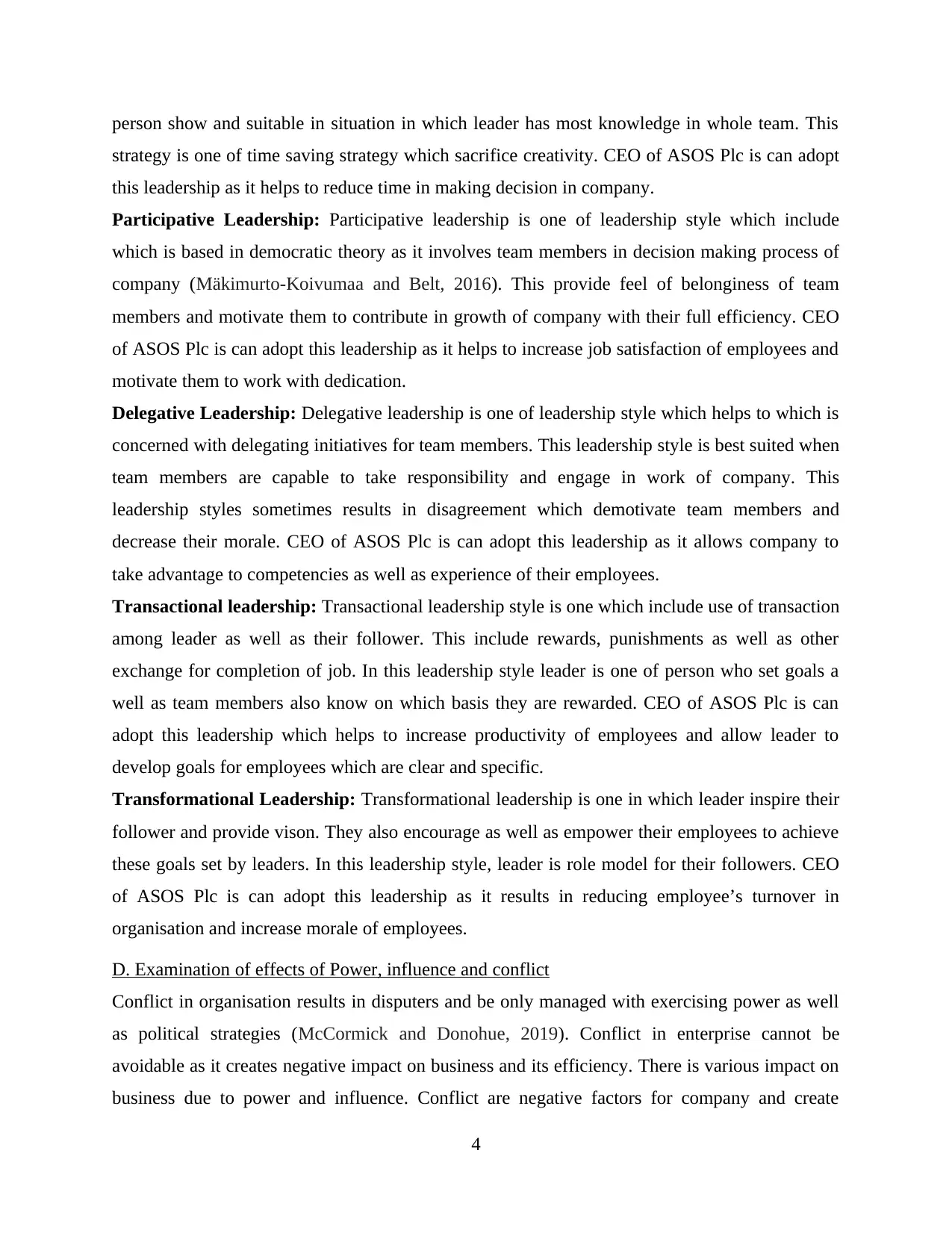
person show and suitable in situation in which leader has most knowledge in whole team. This
strategy is one of time saving strategy which sacrifice creativity. CEO of ASOS Plc is can adopt
this leadership as it helps to reduce time in making decision in company.
Participative Leadership: Participative leadership is one of leadership style which include
which is based in democratic theory as it involves team members in decision making process of
company (Mäkimurto-Koivumaa and Belt, 2016). This provide feel of belonginess of team
members and motivate them to contribute in growth of company with their full efficiency. CEO
of ASOS Plc is can adopt this leadership as it helps to increase job satisfaction of employees and
motivate them to work with dedication.
Delegative Leadership: Delegative leadership is one of leadership style which helps to which is
concerned with delegating initiatives for team members. This leadership style is best suited when
team members are capable to take responsibility and engage in work of company. This
leadership styles sometimes results in disagreement which demotivate team members and
decrease their morale. CEO of ASOS Plc is can adopt this leadership as it allows company to
take advantage to competencies as well as experience of their employees.
Transactional leadership: Transactional leadership style is one which include use of transaction
among leader as well as their follower. This include rewards, punishments as well as other
exchange for completion of job. In this leadership style leader is one of person who set goals a
well as team members also know on which basis they are rewarded. CEO of ASOS Plc is can
adopt this leadership which helps to increase productivity of employees and allow leader to
develop goals for employees which are clear and specific.
Transformational Leadership: Transformational leadership is one in which leader inspire their
follower and provide vison. They also encourage as well as empower their employees to achieve
these goals set by leaders. In this leadership style, leader is role model for their followers. CEO
of ASOS Plc is can adopt this leadership as it results in reducing employee’s turnover in
organisation and increase morale of employees.
D. Examination of effects of Power, influence and conflict
Conflict in organisation results in disputers and be only managed with exercising power as well
as political strategies (McCormick and Donohue, 2019). Conflict in enterprise cannot be
avoidable as it creates negative impact on business and its efficiency. There is various impact on
business due to power and influence. Conflict are negative factors for company and create
4
strategy is one of time saving strategy which sacrifice creativity. CEO of ASOS Plc is can adopt
this leadership as it helps to reduce time in making decision in company.
Participative Leadership: Participative leadership is one of leadership style which include
which is based in democratic theory as it involves team members in decision making process of
company (Mäkimurto-Koivumaa and Belt, 2016). This provide feel of belonginess of team
members and motivate them to contribute in growth of company with their full efficiency. CEO
of ASOS Plc is can adopt this leadership as it helps to increase job satisfaction of employees and
motivate them to work with dedication.
Delegative Leadership: Delegative leadership is one of leadership style which helps to which is
concerned with delegating initiatives for team members. This leadership style is best suited when
team members are capable to take responsibility and engage in work of company. This
leadership styles sometimes results in disagreement which demotivate team members and
decrease their morale. CEO of ASOS Plc is can adopt this leadership as it allows company to
take advantage to competencies as well as experience of their employees.
Transactional leadership: Transactional leadership style is one which include use of transaction
among leader as well as their follower. This include rewards, punishments as well as other
exchange for completion of job. In this leadership style leader is one of person who set goals a
well as team members also know on which basis they are rewarded. CEO of ASOS Plc is can
adopt this leadership which helps to increase productivity of employees and allow leader to
develop goals for employees which are clear and specific.
Transformational Leadership: Transformational leadership is one in which leader inspire their
follower and provide vison. They also encourage as well as empower their employees to achieve
these goals set by leaders. In this leadership style, leader is role model for their followers. CEO
of ASOS Plc is can adopt this leadership as it results in reducing employee’s turnover in
organisation and increase morale of employees.
D. Examination of effects of Power, influence and conflict
Conflict in organisation results in disputers and be only managed with exercising power as well
as political strategies (McCormick and Donohue, 2019). Conflict in enterprise cannot be
avoidable as it creates negative impact on business and its efficiency. There is various impact on
business due to power and influence. Conflict are negative factors for company and create
4
Paraphrase This Document
Need a fresh take? Get an instant paraphrase of this document with our AI Paraphraser
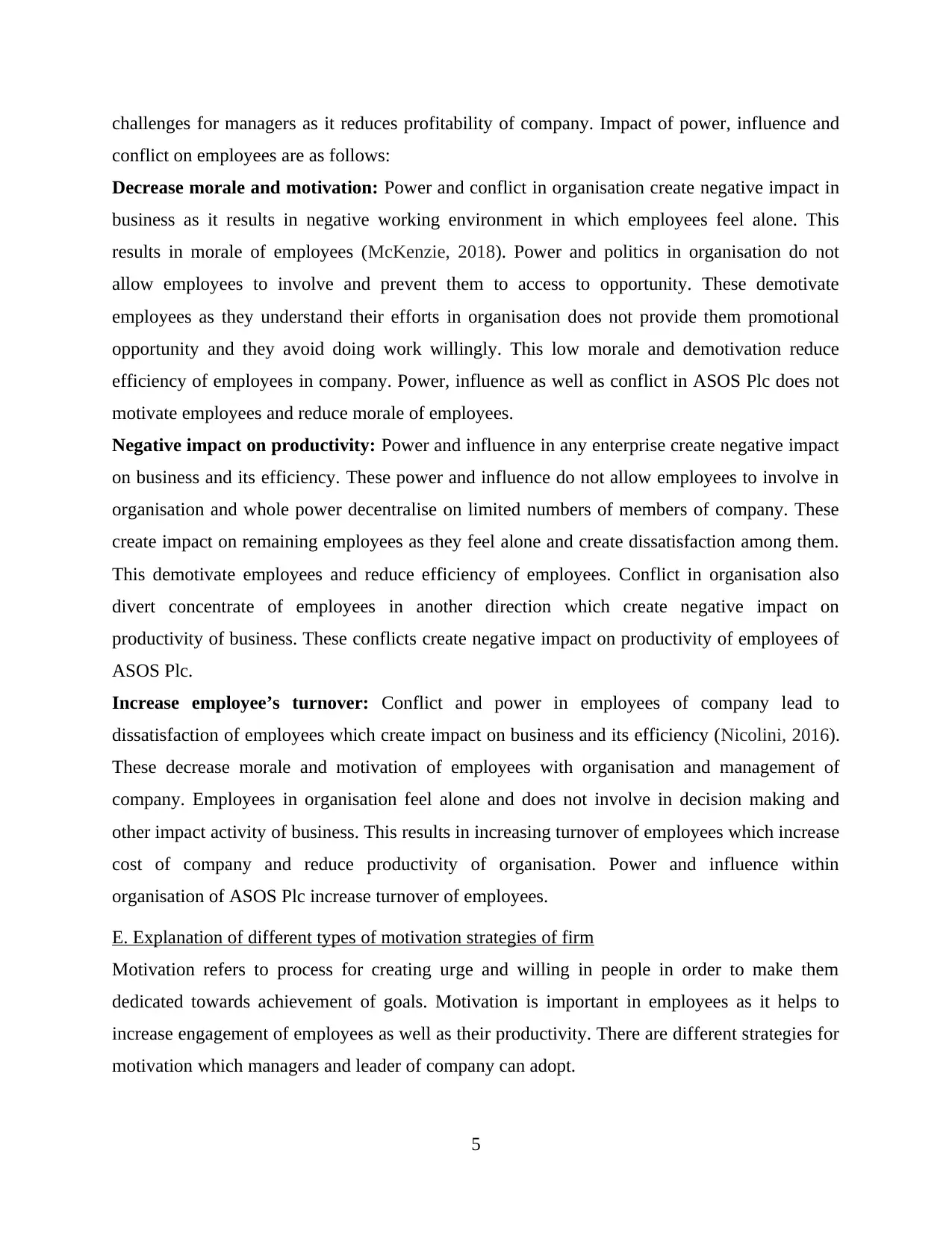
challenges for managers as it reduces profitability of company. Impact of power, influence and
conflict on employees are as follows:
Decrease morale and motivation: Power and conflict in organisation create negative impact in
business as it results in negative working environment in which employees feel alone. This
results in morale of employees (McKenzie, 2018). Power and politics in organisation do not
allow employees to involve and prevent them to access to opportunity. These demotivate
employees as they understand their efforts in organisation does not provide them promotional
opportunity and they avoid doing work willingly. This low morale and demotivation reduce
efficiency of employees in company. Power, influence as well as conflict in ASOS Plc does not
motivate employees and reduce morale of employees.
Negative impact on productivity: Power and influence in any enterprise create negative impact
on business and its efficiency. These power and influence do not allow employees to involve in
organisation and whole power decentralise on limited numbers of members of company. These
create impact on remaining employees as they feel alone and create dissatisfaction among them.
This demotivate employees and reduce efficiency of employees. Conflict in organisation also
divert concentrate of employees in another direction which create negative impact on
productivity of business. These conflicts create negative impact on productivity of employees of
ASOS Plc.
Increase employee’s turnover: Conflict and power in employees of company lead to
dissatisfaction of employees which create impact on business and its efficiency (Nicolini, 2016).
These decrease morale and motivation of employees with organisation and management of
company. Employees in organisation feel alone and does not involve in decision making and
other impact activity of business. This results in increasing turnover of employees which increase
cost of company and reduce productivity of organisation. Power and influence within
organisation of ASOS Plc increase turnover of employees.
E. Explanation of different types of motivation strategies of firm
Motivation refers to process for creating urge and willing in people in order to make them
dedicated towards achievement of goals. Motivation is important in employees as it helps to
increase engagement of employees as well as their productivity. There are different strategies for
motivation which managers and leader of company can adopt.
5
conflict on employees are as follows:
Decrease morale and motivation: Power and conflict in organisation create negative impact in
business as it results in negative working environment in which employees feel alone. This
results in morale of employees (McKenzie, 2018). Power and politics in organisation do not
allow employees to involve and prevent them to access to opportunity. These demotivate
employees as they understand their efforts in organisation does not provide them promotional
opportunity and they avoid doing work willingly. This low morale and demotivation reduce
efficiency of employees in company. Power, influence as well as conflict in ASOS Plc does not
motivate employees and reduce morale of employees.
Negative impact on productivity: Power and influence in any enterprise create negative impact
on business and its efficiency. These power and influence do not allow employees to involve in
organisation and whole power decentralise on limited numbers of members of company. These
create impact on remaining employees as they feel alone and create dissatisfaction among them.
This demotivate employees and reduce efficiency of employees. Conflict in organisation also
divert concentrate of employees in another direction which create negative impact on
productivity of business. These conflicts create negative impact on productivity of employees of
ASOS Plc.
Increase employee’s turnover: Conflict and power in employees of company lead to
dissatisfaction of employees which create impact on business and its efficiency (Nicolini, 2016).
These decrease morale and motivation of employees with organisation and management of
company. Employees in organisation feel alone and does not involve in decision making and
other impact activity of business. This results in increasing turnover of employees which increase
cost of company and reduce productivity of organisation. Power and influence within
organisation of ASOS Plc increase turnover of employees.
E. Explanation of different types of motivation strategies of firm
Motivation refers to process for creating urge and willing in people in order to make them
dedicated towards achievement of goals. Motivation is important in employees as it helps to
increase engagement of employees as well as their productivity. There are different strategies for
motivation which managers and leader of company can adopt.
5
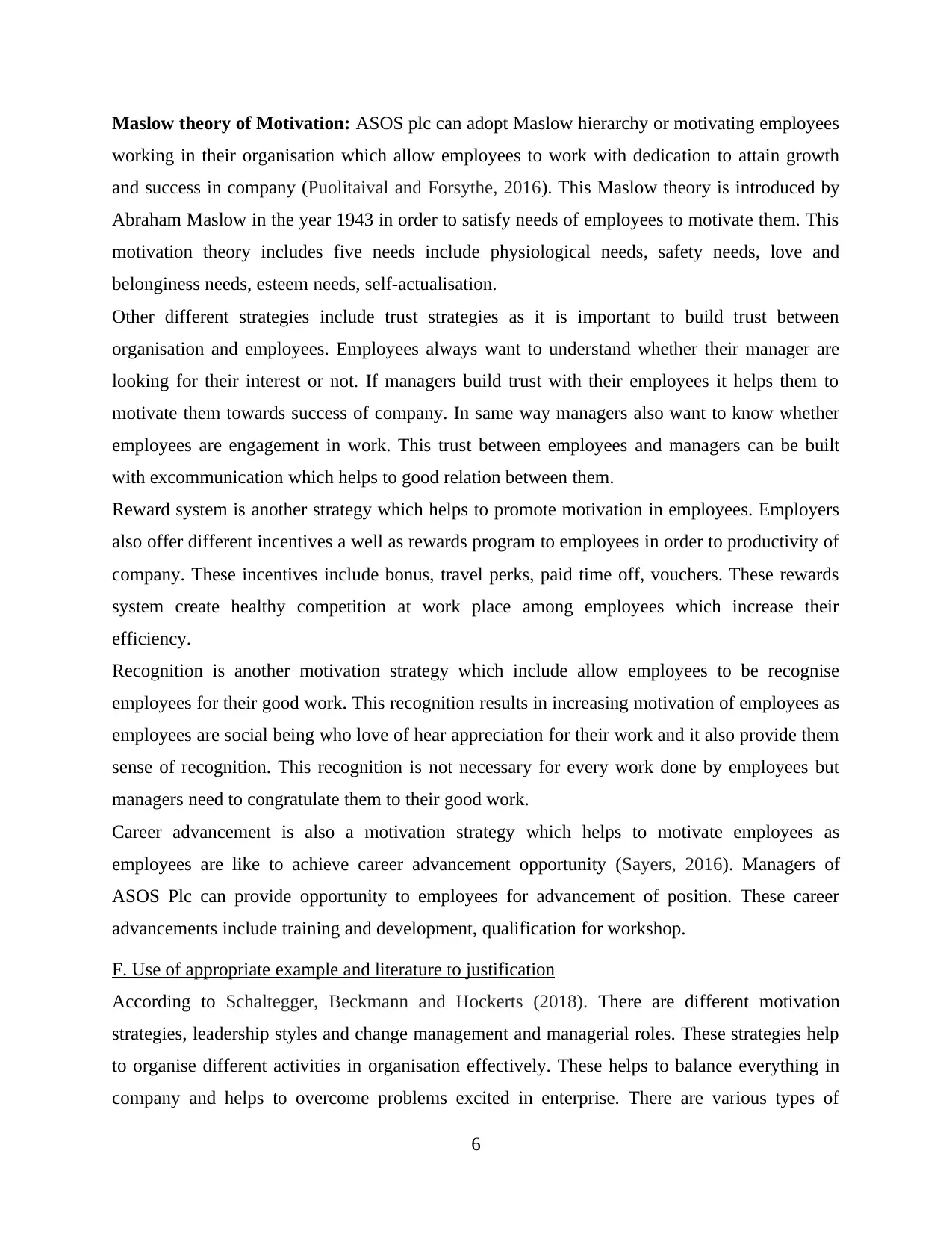
Maslow theory of Motivation: ASOS plc can adopt Maslow hierarchy or motivating employees
working in their organisation which allow employees to work with dedication to attain growth
and success in company (Puolitaival and Forsythe, 2016). This Maslow theory is introduced by
Abraham Maslow in the year 1943 in order to satisfy needs of employees to motivate them. This
motivation theory includes five needs include physiological needs, safety needs, love and
belonginess needs, esteem needs, self-actualisation.
Other different strategies include trust strategies as it is important to build trust between
organisation and employees. Employees always want to understand whether their manager are
looking for their interest or not. If managers build trust with their employees it helps them to
motivate them towards success of company. In same way managers also want to know whether
employees are engagement in work. This trust between employees and managers can be built
with excommunication which helps to good relation between them.
Reward system is another strategy which helps to promote motivation in employees. Employers
also offer different incentives a well as rewards program to employees in order to productivity of
company. These incentives include bonus, travel perks, paid time off, vouchers. These rewards
system create healthy competition at work place among employees which increase their
efficiency.
Recognition is another motivation strategy which include allow employees to be recognise
employees for their good work. This recognition results in increasing motivation of employees as
employees are social being who love of hear appreciation for their work and it also provide them
sense of recognition. This recognition is not necessary for every work done by employees but
managers need to congratulate them to their good work.
Career advancement is also a motivation strategy which helps to motivate employees as
employees are like to achieve career advancement opportunity (Sayers, 2016). Managers of
ASOS Plc can provide opportunity to employees for advancement of position. These career
advancements include training and development, qualification for workshop.
F. Use of appropriate example and literature to justification
According to Schaltegger, Beckmann and Hockerts (2018). There are different motivation
strategies, leadership styles and change management and managerial roles. These strategies help
to organise different activities in organisation effectively. These helps to balance everything in
company and helps to overcome problems excited in enterprise. There are various types of
6
working in their organisation which allow employees to work with dedication to attain growth
and success in company (Puolitaival and Forsythe, 2016). This Maslow theory is introduced by
Abraham Maslow in the year 1943 in order to satisfy needs of employees to motivate them. This
motivation theory includes five needs include physiological needs, safety needs, love and
belonginess needs, esteem needs, self-actualisation.
Other different strategies include trust strategies as it is important to build trust between
organisation and employees. Employees always want to understand whether their manager are
looking for their interest or not. If managers build trust with their employees it helps them to
motivate them towards success of company. In same way managers also want to know whether
employees are engagement in work. This trust between employees and managers can be built
with excommunication which helps to good relation between them.
Reward system is another strategy which helps to promote motivation in employees. Employers
also offer different incentives a well as rewards program to employees in order to productivity of
company. These incentives include bonus, travel perks, paid time off, vouchers. These rewards
system create healthy competition at work place among employees which increase their
efficiency.
Recognition is another motivation strategy which include allow employees to be recognise
employees for their good work. This recognition results in increasing motivation of employees as
employees are social being who love of hear appreciation for their work and it also provide them
sense of recognition. This recognition is not necessary for every work done by employees but
managers need to congratulate them to their good work.
Career advancement is also a motivation strategy which helps to motivate employees as
employees are like to achieve career advancement opportunity (Sayers, 2016). Managers of
ASOS Plc can provide opportunity to employees for advancement of position. These career
advancements include training and development, qualification for workshop.
F. Use of appropriate example and literature to justification
According to Schaltegger, Beckmann and Hockerts (2018). There are different motivation
strategies, leadership styles and change management and managerial roles. These strategies help
to organise different activities in organisation effectively. These helps to balance everything in
company and helps to overcome problems excited in enterprise. There are various types of
6
⊘ This is a preview!⊘
Do you want full access?
Subscribe today to unlock all pages.

Trusted by 1+ million students worldwide
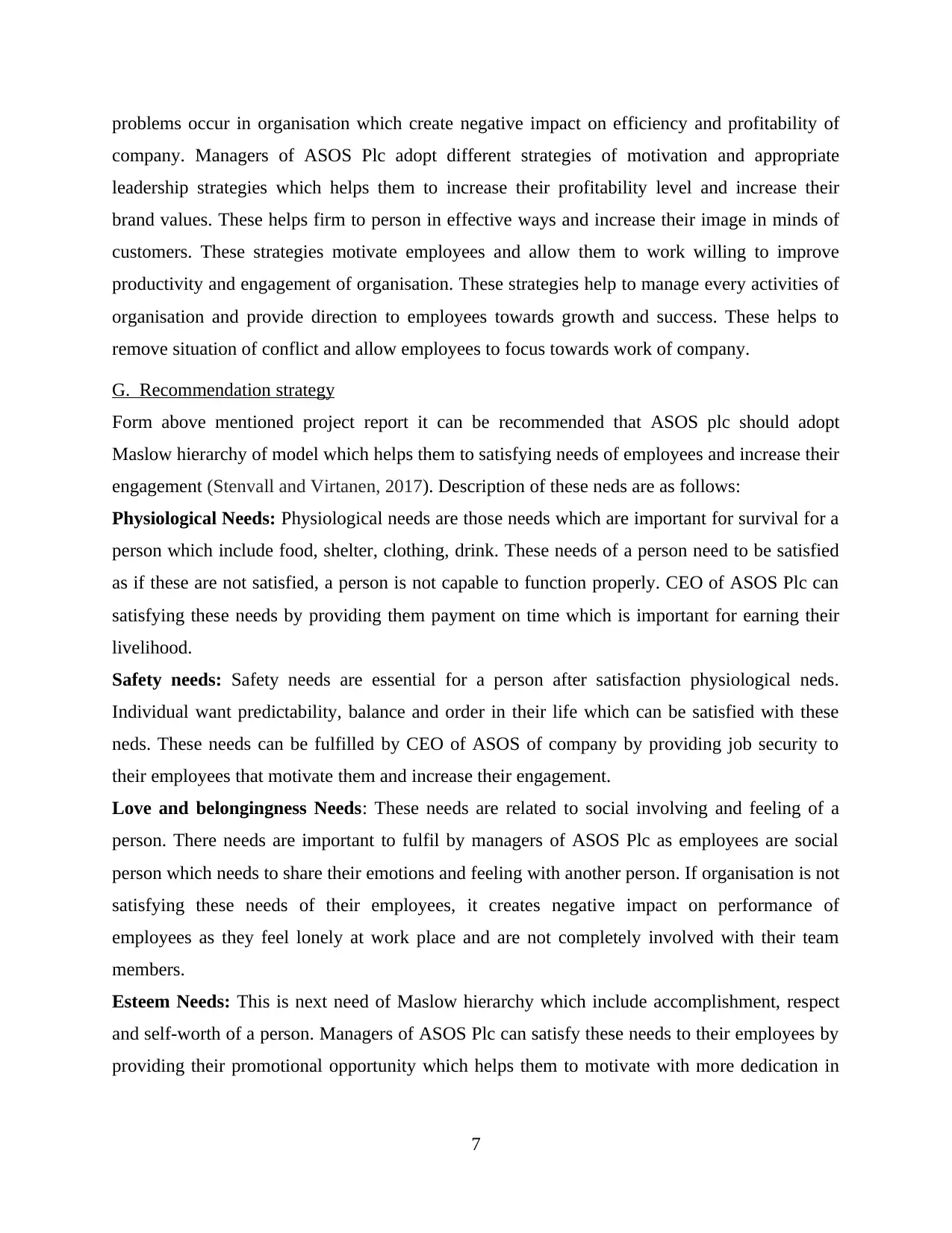
problems occur in organisation which create negative impact on efficiency and profitability of
company. Managers of ASOS Plc adopt different strategies of motivation and appropriate
leadership strategies which helps them to increase their profitability level and increase their
brand values. These helps firm to person in effective ways and increase their image in minds of
customers. These strategies motivate employees and allow them to work willing to improve
productivity and engagement of organisation. These strategies help to manage every activities of
organisation and provide direction to employees towards growth and success. These helps to
remove situation of conflict and allow employees to focus towards work of company.
G. Recommendation strategy
Form above mentioned project report it can be recommended that ASOS plc should adopt
Maslow hierarchy of model which helps them to satisfying needs of employees and increase their
engagement (Stenvall and Virtanen, 2017). Description of these neds are as follows:
Physiological Needs: Physiological needs are those needs which are important for survival for a
person which include food, shelter, clothing, drink. These needs of a person need to be satisfied
as if these are not satisfied, a person is not capable to function properly. CEO of ASOS Plc can
satisfying these needs by providing them payment on time which is important for earning their
livelihood.
Safety needs: Safety needs are essential for a person after satisfaction physiological neds.
Individual want predictability, balance and order in their life which can be satisfied with these
neds. These needs can be fulfilled by CEO of ASOS of company by providing job security to
their employees that motivate them and increase their engagement.
Love and belongingness Needs: These needs are related to social involving and feeling of a
person. There needs are important to fulfil by managers of ASOS Plc as employees are social
person which needs to share their emotions and feeling with another person. If organisation is not
satisfying these needs of their employees, it creates negative impact on performance of
employees as they feel lonely at work place and are not completely involved with their team
members.
Esteem Needs: This is next need of Maslow hierarchy which include accomplishment, respect
and self-worth of a person. Managers of ASOS Plc can satisfy these needs to their employees by
providing their promotional opportunity which helps them to motivate with more dedication in
7
company. Managers of ASOS Plc adopt different strategies of motivation and appropriate
leadership strategies which helps them to increase their profitability level and increase their
brand values. These helps firm to person in effective ways and increase their image in minds of
customers. These strategies motivate employees and allow them to work willing to improve
productivity and engagement of organisation. These strategies help to manage every activities of
organisation and provide direction to employees towards growth and success. These helps to
remove situation of conflict and allow employees to focus towards work of company.
G. Recommendation strategy
Form above mentioned project report it can be recommended that ASOS plc should adopt
Maslow hierarchy of model which helps them to satisfying needs of employees and increase their
engagement (Stenvall and Virtanen, 2017). Description of these neds are as follows:
Physiological Needs: Physiological needs are those needs which are important for survival for a
person which include food, shelter, clothing, drink. These needs of a person need to be satisfied
as if these are not satisfied, a person is not capable to function properly. CEO of ASOS Plc can
satisfying these needs by providing them payment on time which is important for earning their
livelihood.
Safety needs: Safety needs are essential for a person after satisfaction physiological neds.
Individual want predictability, balance and order in their life which can be satisfied with these
neds. These needs can be fulfilled by CEO of ASOS of company by providing job security to
their employees that motivate them and increase their engagement.
Love and belongingness Needs: These needs are related to social involving and feeling of a
person. There needs are important to fulfil by managers of ASOS Plc as employees are social
person which needs to share their emotions and feeling with another person. If organisation is not
satisfying these needs of their employees, it creates negative impact on performance of
employees as they feel lonely at work place and are not completely involved with their team
members.
Esteem Needs: This is next need of Maslow hierarchy which include accomplishment, respect
and self-worth of a person. Managers of ASOS Plc can satisfy these needs to their employees by
providing their promotional opportunity which helps them to motivate with more dedication in
7
Paraphrase This Document
Need a fresh take? Get an instant paraphrase of this document with our AI Paraphraser
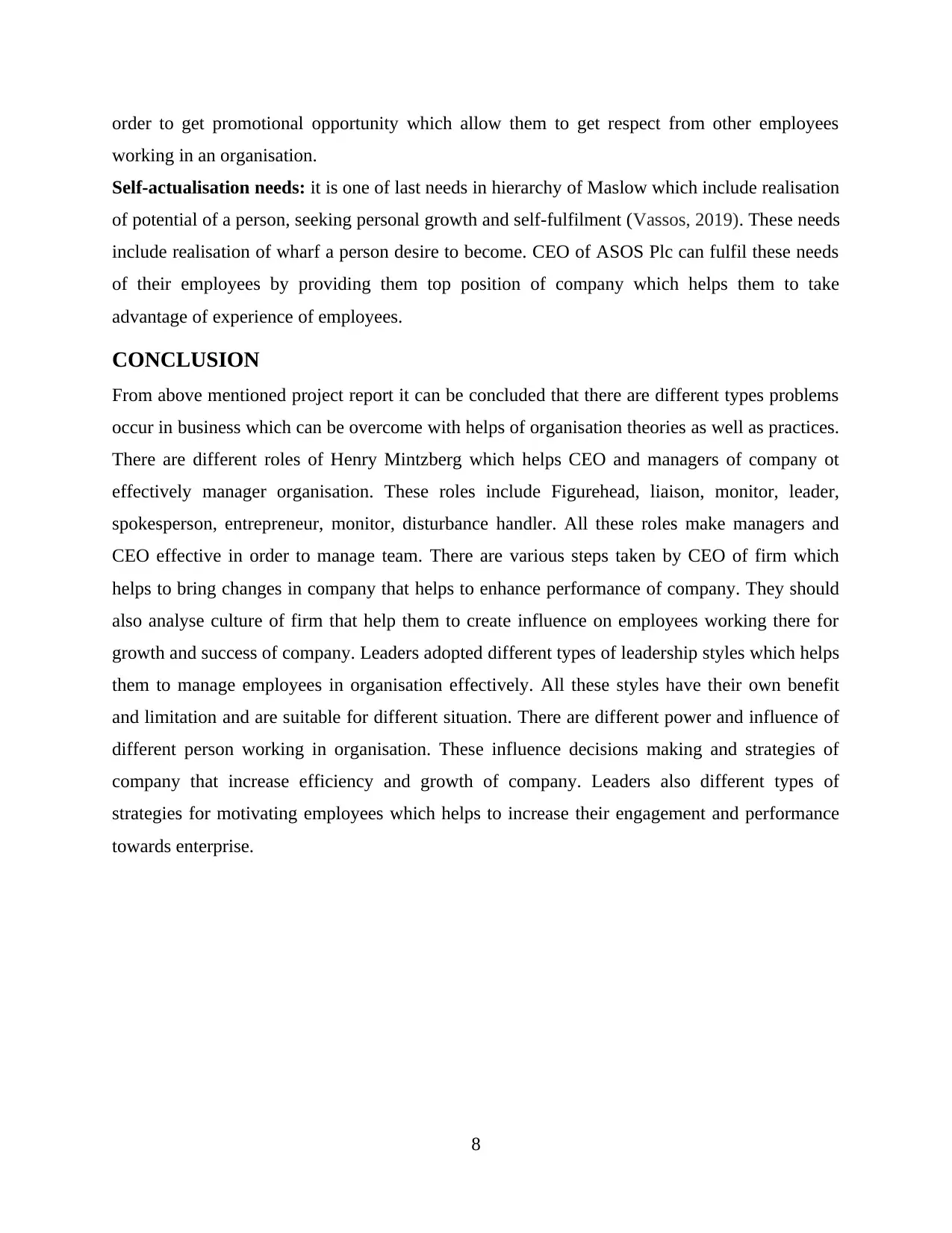
order to get promotional opportunity which allow them to get respect from other employees
working in an organisation.
Self-actualisation needs: it is one of last needs in hierarchy of Maslow which include realisation
of potential of a person, seeking personal growth and self-fulfilment (Vassos, 2019). These needs
include realisation of wharf a person desire to become. CEO of ASOS Plc can fulfil these needs
of their employees by providing them top position of company which helps them to take
advantage of experience of employees.
CONCLUSION
From above mentioned project report it can be concluded that there are different types problems
occur in business which can be overcome with helps of organisation theories as well as practices.
There are different roles of Henry Mintzberg which helps CEO and managers of company ot
effectively manager organisation. These roles include Figurehead, liaison, monitor, leader,
spokesperson, entrepreneur, monitor, disturbance handler. All these roles make managers and
CEO effective in order to manage team. There are various steps taken by CEO of firm which
helps to bring changes in company that helps to enhance performance of company. They should
also analyse culture of firm that help them to create influence on employees working there for
growth and success of company. Leaders adopted different types of leadership styles which helps
them to manage employees in organisation effectively. All these styles have their own benefit
and limitation and are suitable for different situation. There are different power and influence of
different person working in organisation. These influence decisions making and strategies of
company that increase efficiency and growth of company. Leaders also different types of
strategies for motivating employees which helps to increase their engagement and performance
towards enterprise.
8
working in an organisation.
Self-actualisation needs: it is one of last needs in hierarchy of Maslow which include realisation
of potential of a person, seeking personal growth and self-fulfilment (Vassos, 2019). These needs
include realisation of wharf a person desire to become. CEO of ASOS Plc can fulfil these needs
of their employees by providing them top position of company which helps them to take
advantage of experience of employees.
CONCLUSION
From above mentioned project report it can be concluded that there are different types problems
occur in business which can be overcome with helps of organisation theories as well as practices.
There are different roles of Henry Mintzberg which helps CEO and managers of company ot
effectively manager organisation. These roles include Figurehead, liaison, monitor, leader,
spokesperson, entrepreneur, monitor, disturbance handler. All these roles make managers and
CEO effective in order to manage team. There are various steps taken by CEO of firm which
helps to bring changes in company that helps to enhance performance of company. They should
also analyse culture of firm that help them to create influence on employees working there for
growth and success of company. Leaders adopted different types of leadership styles which helps
them to manage employees in organisation effectively. All these styles have their own benefit
and limitation and are suitable for different situation. There are different power and influence of
different person working in organisation. These influence decisions making and strategies of
company that increase efficiency and growth of company. Leaders also different types of
strategies for motivating employees which helps to increase their engagement and performance
towards enterprise.
8
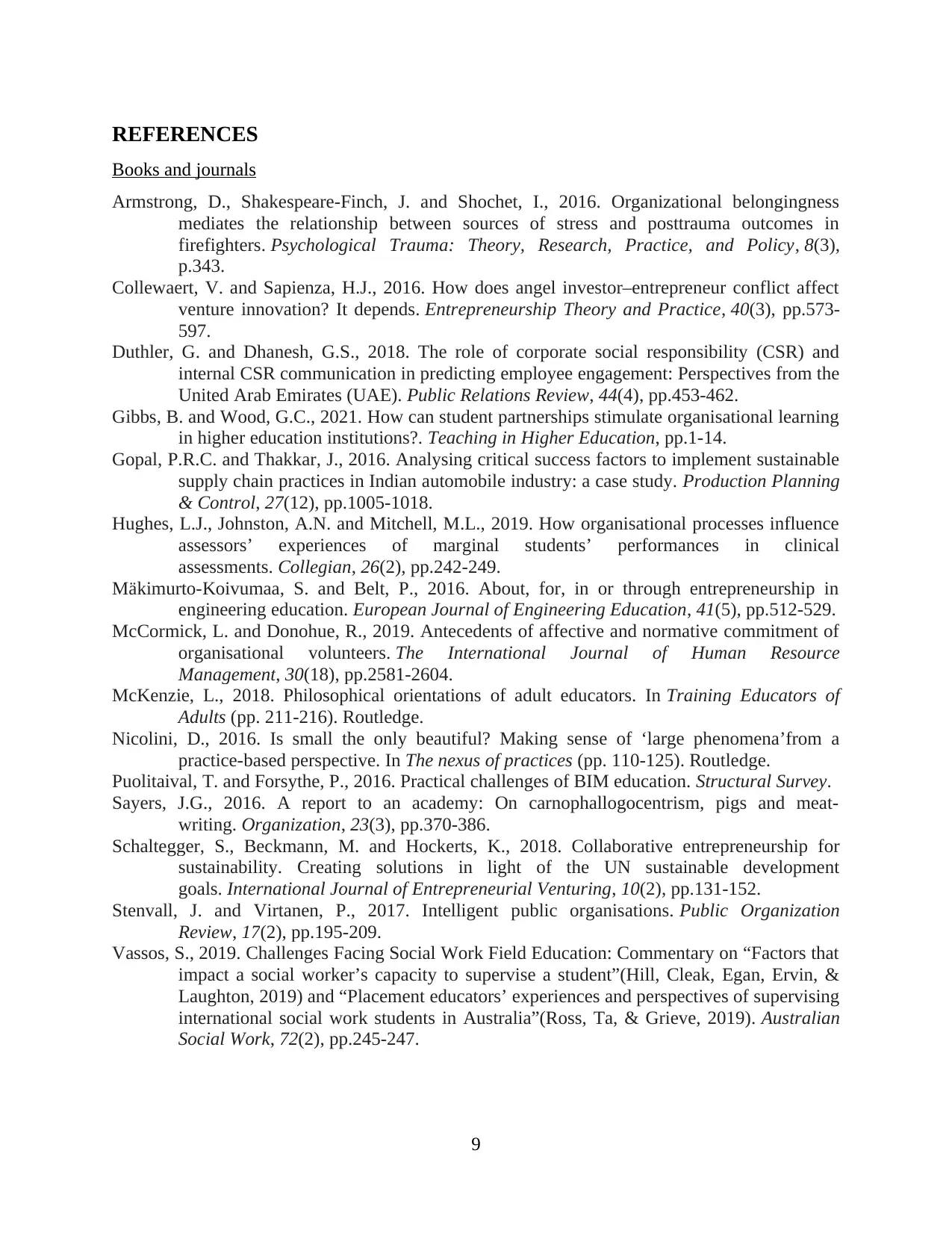
REFERENCES
Books and journals
Armstrong, D., Shakespeare-Finch, J. and Shochet, I., 2016. Organizational belongingness
mediates the relationship between sources of stress and posttrauma outcomes in
firefighters. Psychological Trauma: Theory, Research, Practice, and Policy, 8(3),
p.343.
Collewaert, V. and Sapienza, H.J., 2016. How does angel investor–entrepreneur conflict affect
venture innovation? It depends. Entrepreneurship Theory and Practice, 40(3), pp.573-
597.
Duthler, G. and Dhanesh, G.S., 2018. The role of corporate social responsibility (CSR) and
internal CSR communication in predicting employee engagement: Perspectives from the
United Arab Emirates (UAE). Public Relations Review, 44(4), pp.453-462.
Gibbs, B. and Wood, G.C., 2021. How can student partnerships stimulate organisational learning
in higher education institutions?. Teaching in Higher Education, pp.1-14.
Gopal, P.R.C. and Thakkar, J., 2016. Analysing critical success factors to implement sustainable
supply chain practices in Indian automobile industry: a case study. Production Planning
& Control, 27(12), pp.1005-1018.
Hughes, L.J., Johnston, A.N. and Mitchell, M.L., 2019. How organisational processes influence
assessors’ experiences of marginal students’ performances in clinical
assessments. Collegian, 26(2), pp.242-249.
Mäkimurto-Koivumaa, S. and Belt, P., 2016. About, for, in or through entrepreneurship in
engineering education. European Journal of Engineering Education, 41(5), pp.512-529.
McCormick, L. and Donohue, R., 2019. Antecedents of affective and normative commitment of
organisational volunteers. The International Journal of Human Resource
Management, 30(18), pp.2581-2604.
McKenzie, L., 2018. Philosophical orientations of adult educators. In Training Educators of
Adults (pp. 211-216). Routledge.
Nicolini, D., 2016. Is small the only beautiful? Making sense of ‘large phenomena’from a
practice-based perspective. In The nexus of practices (pp. 110-125). Routledge.
Puolitaival, T. and Forsythe, P., 2016. Practical challenges of BIM education. Structural Survey.
Sayers, J.G., 2016. A report to an academy: On carnophallogocentrism, pigs and meat-
writing. Organization, 23(3), pp.370-386.
Schaltegger, S., Beckmann, M. and Hockerts, K., 2018. Collaborative entrepreneurship for
sustainability. Creating solutions in light of the UN sustainable development
goals. International Journal of Entrepreneurial Venturing, 10(2), pp.131-152.
Stenvall, J. and Virtanen, P., 2017. Intelligent public organisations. Public Organization
Review, 17(2), pp.195-209.
Vassos, S., 2019. Challenges Facing Social Work Field Education: Commentary on “Factors that
impact a social worker’s capacity to supervise a student”(Hill, Cleak, Egan, Ervin, &
Laughton, 2019) and “Placement educators’ experiences and perspectives of supervising
international social work students in Australia”(Ross, Ta, & Grieve, 2019). Australian
Social Work, 72(2), pp.245-247.
9
Books and journals
Armstrong, D., Shakespeare-Finch, J. and Shochet, I., 2016. Organizational belongingness
mediates the relationship between sources of stress and posttrauma outcomes in
firefighters. Psychological Trauma: Theory, Research, Practice, and Policy, 8(3),
p.343.
Collewaert, V. and Sapienza, H.J., 2016. How does angel investor–entrepreneur conflict affect
venture innovation? It depends. Entrepreneurship Theory and Practice, 40(3), pp.573-
597.
Duthler, G. and Dhanesh, G.S., 2018. The role of corporate social responsibility (CSR) and
internal CSR communication in predicting employee engagement: Perspectives from the
United Arab Emirates (UAE). Public Relations Review, 44(4), pp.453-462.
Gibbs, B. and Wood, G.C., 2021. How can student partnerships stimulate organisational learning
in higher education institutions?. Teaching in Higher Education, pp.1-14.
Gopal, P.R.C. and Thakkar, J., 2016. Analysing critical success factors to implement sustainable
supply chain practices in Indian automobile industry: a case study. Production Planning
& Control, 27(12), pp.1005-1018.
Hughes, L.J., Johnston, A.N. and Mitchell, M.L., 2019. How organisational processes influence
assessors’ experiences of marginal students’ performances in clinical
assessments. Collegian, 26(2), pp.242-249.
Mäkimurto-Koivumaa, S. and Belt, P., 2016. About, for, in or through entrepreneurship in
engineering education. European Journal of Engineering Education, 41(5), pp.512-529.
McCormick, L. and Donohue, R., 2019. Antecedents of affective and normative commitment of
organisational volunteers. The International Journal of Human Resource
Management, 30(18), pp.2581-2604.
McKenzie, L., 2018. Philosophical orientations of adult educators. In Training Educators of
Adults (pp. 211-216). Routledge.
Nicolini, D., 2016. Is small the only beautiful? Making sense of ‘large phenomena’from a
practice-based perspective. In The nexus of practices (pp. 110-125). Routledge.
Puolitaival, T. and Forsythe, P., 2016. Practical challenges of BIM education. Structural Survey.
Sayers, J.G., 2016. A report to an academy: On carnophallogocentrism, pigs and meat-
writing. Organization, 23(3), pp.370-386.
Schaltegger, S., Beckmann, M. and Hockerts, K., 2018. Collaborative entrepreneurship for
sustainability. Creating solutions in light of the UN sustainable development
goals. International Journal of Entrepreneurial Venturing, 10(2), pp.131-152.
Stenvall, J. and Virtanen, P., 2017. Intelligent public organisations. Public Organization
Review, 17(2), pp.195-209.
Vassos, S., 2019. Challenges Facing Social Work Field Education: Commentary on “Factors that
impact a social worker’s capacity to supervise a student”(Hill, Cleak, Egan, Ervin, &
Laughton, 2019) and “Placement educators’ experiences and perspectives of supervising
international social work students in Australia”(Ross, Ta, & Grieve, 2019). Australian
Social Work, 72(2), pp.245-247.
9
⊘ This is a preview!⊘
Do you want full access?
Subscribe today to unlock all pages.

Trusted by 1+ million students worldwide
1 out of 13
Related Documents
Your All-in-One AI-Powered Toolkit for Academic Success.
+13062052269
info@desklib.com
Available 24*7 on WhatsApp / Email
![[object Object]](/_next/static/media/star-bottom.7253800d.svg)
Unlock your academic potential
Copyright © 2020–2025 A2Z Services. All Rights Reserved. Developed and managed by ZUCOL.




